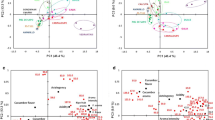Abstract
High correlations were observed between the flavor evaluation procedure and objective chemical tests for measuring oxidative deterioration in stored corn, cottonseed, safflower, and soybean oils. The high correlations observed are believed to result from the precision of the flavor threshold testing procedure. Therefore, when suitable flavor testing methods are employed, the chemical methods become more valuable in assessing the quality of an oil. Milk is recommended as the testing media because of its desirable properties.
Similar content being viewed by others
References
AOCS, Official and Tentative Methods of Analysis, Tentative Method Cd 8–53, Chicago, Ill. (1958).
Keith, R. W., and E. A. Day, JAOCS40, 121–124 (1963).
Lillard, D. A., and E. A. Day, J. Dairy Sci.44, 623–632 (1961).
Sinnhuber, R. O., and T. C. Yu, Food Technol.12, 9–12 (1958).
Author information
Authors and Affiliations
Additional information
Technical Paper No. 1833, Oregon Agricultural Experiment Station, Corvallis.
About this article
Cite this article
Wyatt, C.J., Day, E.A. A simplified and precise flavor evaluation procedure for determining oxidative rancidity in vegetable oils. J Am Oil Chem Soc 42, 734–736 (1965). https://doi.org/10.1007/BF02540051
Received:
Accepted:
Issue Date:
DOI: https://doi.org/10.1007/BF02540051




